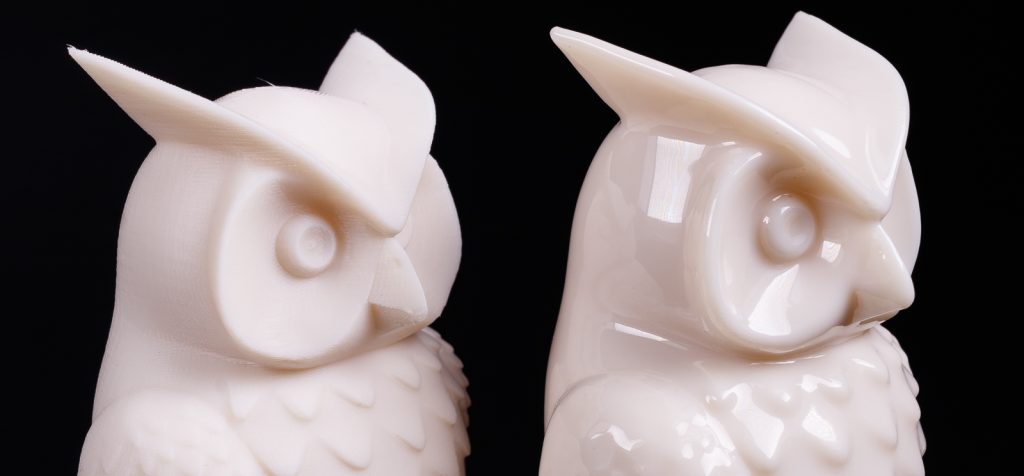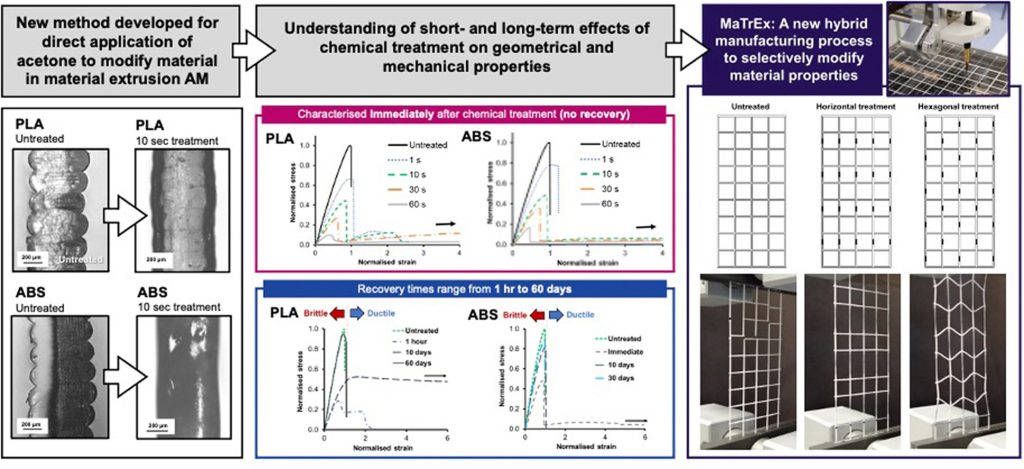The 2021 3D Printing Industry Awards shortlists are now open for voting until the 20th of October. Cast your votes here.
Researchers at Loughborough University have developed a novel hybrid 3D printing technique that allows them to change the properties of printed parts over time, enabling a new form of 4D printing.
Named Material Treatment Extrusion Additive Manufacturing (MaTrEx-AM), the approach combines conventional extrusion-based 3D printing with a chemical treatment. Specifically, it leverages the organic chemical acetone to make targetted layers in a 3D printed object more durable. Depending on how the acetone is distributed and how much of it is applied between layers, the technique makes it possible to 3D print parts with modifiable mechanical properties, allowing users to control how they deform under load.
Dr Andy Gleadall, senior lecturer in additive manufacturing and co-author of the study, said, “The new capabilities are potentially valuable for a huge range of parts and structures, but perhaps the most obvious ones would be parts that deform during operation, and the way in which they deform needs to be controlled. The time-dependent nature of mechanical properties means the approach adds a new dimension to material capabilities, with in-situ hybrid processing facilitating a true 4D printing process.”

Acetone and 3D printing
Acetone is a common solvent used in everything from nail polish removal products to gasoline and grease cutters. In the 3D printing industry, the compound has its use as a surface finisher as it can dissolve polymers like ABS, enabling users to smooth over layer lines to make them invisible. The MaTrEx-AM process takes this concept a step further, applying acetone in-situ between layers rather than on the exteriors of printed parts.
But how does acetone change the mechanical properties of these printed layers? The answer lies in how filament is extruded by conventional FDM 3D printers. Since FDM systems deposit molten filament out of a circular-shaped nozzle, the tracks produced are of a cylindrical shape. This results in the contact area between the tracks being relatively small, giving rise to insufficient layer bonding and, ultimately, weaker parts.
Gleadall explains, “The process adds material layer-by-layer – there are grooves between the layers, a bit like you’d see if you stacked a lot of logs sideways on top of one another, all lined up. 3D printed parts are often weak because of the way layers are laid down in sequence, so there are geometric defects between the layers and the bonding of material between layers may not be as good as the pure polymer.”
By applying acetone to these cylindrical tracks, it’s possible to melt them together for better fusion. This increases the contact area and the strength of the bonds, which gives rise to controllable mechanical properties (and programmable deformation profiles) via selective acetone application.

Helmet padding and biomedical implants
Gleadall’s team found that they could increase the plasticity of PLA and ABS parts by up to 25- and 16-fold by applying acetone, increasing the toughness of the treated areas. However, in the long term, the mechanical properties of these parts recovered to their original values by up to 90%, which is where the 4D comes in. This recovery happened within three hours for ABS, while PLA specimens took up to 60 days to recover. Importantly, even after the printed parts recovered their properties, any geometrical changes made in that time were retained.
According to the Loughborough team, the real-world applications of MaTrEx-AM include 4D lattice structures for impact-resistant helmet padding, as well as dynamic biomedical implants that deform along with the anatomy of the patient.
Further details of the study can be found in the paper titled MaTrEx AM: A new hybrid additive manufacturing process to selectively control mechanical properties.

In the academic sphere, 4D printing has proven itself to be a great tool for applications such as medical devices and soft robots. Researchers from the University of Freiburg and the University of Stuttgart recently developed a novel method of 4D printing a wearable wrist splint that self-adjusts to the anatomy of the patient. Inspired by the propagation mechanism of the air potato plant (Dioscorea bulbifera), the printed system can be pre-programmed to carry out complex movements when exposed to moisture.
Elsewhere, at Tianjin University, China, scientists recently 4D printed a self-propelling soft robot capable of roaming around on its own. The tube-shaped robot is made of a material called a liquid crystal elastomer, and it self-assembles when in contact with heat. The device leverages cleverly programmed fold patterns to induce strain within its own body, which enables it to roll over like a log.
Subscribe to the 3D Printing Industry newsletter for the latest news in additive manufacturing. You can also stay connected by following us on Twitter, liking us on Facebook, and tuning into the 3D Printing Industry YouTube Channel.
Looking for a career in additive manufacturing? Visit 3D Printing Jobs for a selection of roles in the industry.
Featured image shows Loughborough University campus. Photo via Loughborough University.



